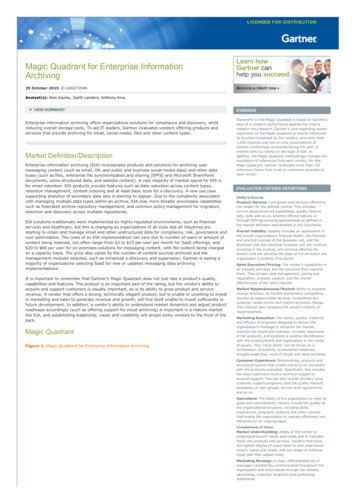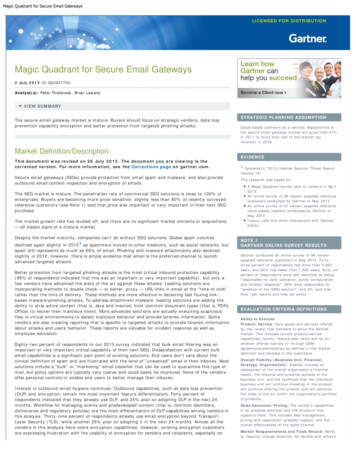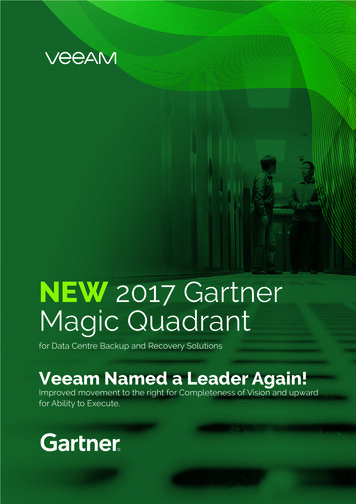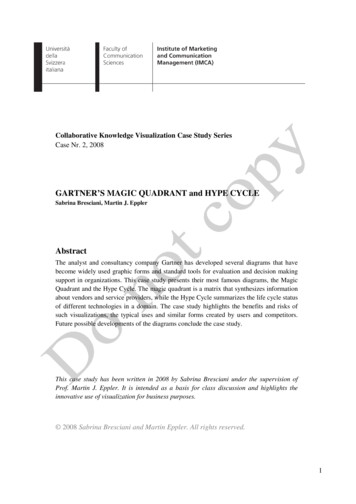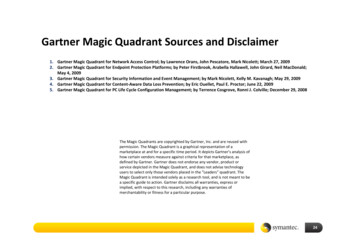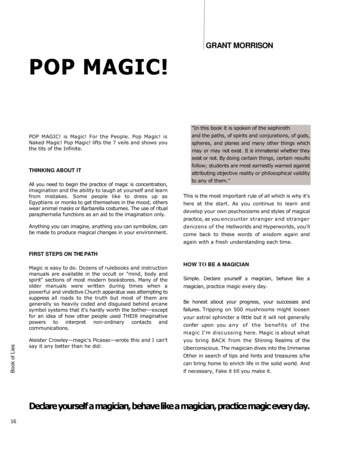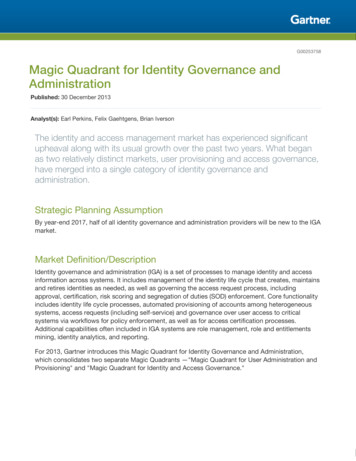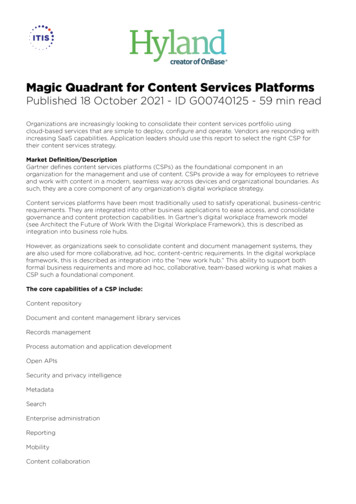
Transcription
Magic Quadrant for Content Services PlatformsPublished 18 October 2021 - ID G00740125 - 59 min readOrganizations are increasingly looking to consolidate their content services portfolio usingcloud-based services that are simple to deploy, configure and operate. Vendors are responding withincreasing SaaS capabilities. Application leaders should use this report to select the right CSP fortheir content services strategy.Market Definition/DescriptionGartner defines content services platforms (CSPs) as the foundational component in anorganization for the management and use of content. CSPs provide a way for employees to retrieveand work with content in a modern, seamless way across devices and organizational boundaries. Assuch, they are a core component of any organization’s digital workplace strategy.Content services platforms have been most traditionally used to satisfy operational, business-centricrequirements. They are integrated into other business applications to ease access, and consolidategovernance and content protection capabilities. In Gartner’s digital workplace framework model(see Architect the Future of Work With the Digital Workplace Framework), this is described asintegration into business role hubs.However, as organizations seek to consolidate content and document management systems, theyare also used for more collaborative, ad hoc, content-centric requirements. In the digital workplaceframework, this is described as integration into the “new work hub.” This ability to support bothformal business requirements and more ad hoc, collaborative, team-based working is what makes aCSP such a foundational component.The core capabilities of a CSP include:Content repositoryDocument and content management library servicesRecords managementProcess automation and application developmentOpen APIsSecurity and privacy intelligenceMetadataSearchEnterprise administrationReportingMobilityContent collaboration
The optional capabilities of a CSP include:Content intelligenceProductivity intelligenceNew work hub connectorsBusiness role hub connectorsFederationPaaS/SaaS deploymentA full description of each of these services is present in the accompanying CriticalCapabilities for Content Services Platform.The content services market is well established with many vendors having hadproducts in this space for over 30 years. As such, many of the core capabilitieshave become commodity features with little differentiation. Newer entrants to themarket have, however, taken a different approach to some of these areas. As suchthe critical capabilities — those capabilities that are highly differentiated and ofmost importance to evaluate when selecting a product in this space — are a blendof core and optional capabilities.These critical capabilities are:Records managementProcess automation and app developmentSecurity and privacy intelligenceContent intelligenceProductivity intelligenceNew work hub connectorsBusiness role hub connectorsFederationContent collaborationPaaS/SaaS deployment
Of these critical functions, it is the last — PaaS/SaaS deployment — whichhas seen the greatest growth in importance over the last few years.Organizations are looking increasingly to modern, cloud-based solutions.Content services has been a traditionalist technology discipline for manyorganizations with on-premises or private hosted solutions being the mostcommonly deployed model. This is changing rapidly with a majority ofGartner inquiries now focusing on cloud deployments to modern existingimplementations. This increased importance of true cloud solutions isreflected in our market analysis this year.Vendor Strengths and CautionsAODocsAODocs is a Niche Player in this Magic Quadrant. Its CSP, also called AODocs, isbuilt on top of Google Drive and is a multitenant SaaS platform. It provides a fullset of CSP capabilities.AODocs’ operations are primarily in Europe and North America. Its clients tend tobe midsize businesses within key verticals, including life sciences, manufacturingand education.AODocs has made further inroads into the enterprise market in 2021, increasing theproportion of large organizations utilizing the service among its client base.AODocs is extending its platform to offer services on top of Google cloud storage,thereby providing an alternative storage method to customers who cannot or donot want to use Google Drive.
StrengthsGoogle Workspace: AODocs has established itself as a primary consideration fororganizations focused on Google Workspace as their new work hub. It is deeplyembedded into the Google ecosystem and is therefore able to make extensive useof adjacent capabilities such as Google collaboration and AI.SaaS: AODocs is a cloud-native platform with a true multitenant SaaS solution in amarket that still lags in this respect. This makes it good for organizations looking tobenefit from the evergreen nature of cloud services and outsourcing of operationalconcerns. A private cloud, single-tenant version of the services is also available.Growing business solution portfolio: AODocs increased its portfolio ofbusiness-specific applications in 2021, adding solutions for contract managementand invoices to its existing life sciences application. Organizations looking todeploy readymade business solutions with minimal configuration will value this.CautionsGoogle dependency: AODocs is currently dependent on Google Drive for itsunderlying file repository services, which provide content editing capabilities andenable it to be used as a CSP. It is adding support for native Google storage in thenear future, as well as support for non-Google identity services. Organizations thatdo not wish to use Google services should watch for this upcoming version ofAODocs.Organization size: AODocs meets the inclusion criteria for this Magic Quadrant,but is the smallest vendor in terms of revenue, number of employees and partnerecosystems. This presents a risk to large organizations looking to make significantinvestments in the platform, which should be quantified as part of their evaluationof AODocs.Integration limitations: AODocs has a more limited set of integration capabilitieswith enterprise business applications than other major competitors in this MagicQuadrant. For example, it has no integration with SAP or Oracle ERP Cloud, andonly limited Microsoft 365 integration. AODocs incorporates Tray.io to provideconfigurable connectivity to such systems, but this is more limited than competitorofferings.BoxBox is a Leader in this Magic Quadrant. The Box Content Cloud platform is a SaaSand is focused on collaborative employee- and business-centric content needs. Itprovides CSP capabilities in its Enterprise Plus edition, which bundles a range offeatures previously sold individually. The majority of Box customers use theplatform as a secure content collaboration tool. However, to support CSP usecases, Box clients need Box Governance, Box Relay and Box Shield.Box’s operations are primarily in North America, with growing presence in Europeand Asia. It has over 100,000 clients, from SMBs to large enterprises, in keyverticals like financial services, life sciences and the public sector.In 2021, Box announced an expanded relationship with Microsoft and Google Cloud,along with closer integration with Microsoft 365 and Google Workspace. Boxacquired SignRequest in 2021, upon which the new Box Sign service is based, alongwith Cloud FastPath, upon which the new Box Shuttle content migration service isbased.StrengthsCloud content services at scale: Box has scaled its user base and contentrepositories, so that it is viable for business-centric content use cases that requirelarge document sets, governance, security and process automation. While somecore capabilities hold Box back, the signs are that it is closing the gap and
continues to be a viable alternative to traditional vendors in this market.Small- to large-scale customers: Box’s customer base includes organizations anddepartments of all sizes and industries, for whom Box may be their first taste ofsophisticated content management tools. This large customer base bodes well forBox’s ability to grow and upsell to both new and existing customers.Ease of use: Attracting and onboarding over 5,000 new customers each year istestament to the ease of use and adoption rates for Box. Box’s ease of use andintegration with business roles and new work hub connectors like Salesforce, SAP,Microsoft 365 and Google Workspace allow Box to play a broad role in enterpriseapplications delivered securely in the cloud.CautionsPricing model and bundling: Box is encouraging customers to adopt new bundles,including Enterprise Plus, which may lead to increases in subscription fees. Inaddition, API pricing is highly variable and appears expensive for high-volume,customer-centric content use cases based on the proposals Gartner has seen.Clients renewing subscriptions, as Box moves from core Box with upgrades optionsto Enterprise Plus, should carefully evaluate their transactional API needs to ensuregood value.Geofencing: Data residency in the Box Zones module is limited to content only.Metadata stored in Box, along with the rest of the control plane, is stored in thevendor’s U.S. data centers. Slower growth in some markets may reflect concernover Box’s data residency strategy and ability to meet strict regulatoryrequirements. Box’s SaaS solution may not suit clients that have concerns aboutdata residency in the cloud.Capability maturity: Box continues to lag in several key CSP capabilities, includinggranular records management, granular access control, forms and workflow.DocuWareDocuWare is a Niche Player in this Magic Quadrant. It focuses its CSP on tacklingand automating business administration scenarios. It provides all core CSPcapabilities as either on-premises or SaaS deployments.The vendor’s operations are primarily in Europe and North America, with a smallercustomer base in Africa, Asia/Pacific and Australia. The majority of its clients tendto be SMBs with wide distribution across all verticals.DocuWare continues to operate as an autonomous business unit within Ricoh, itsparent company. Recent DocuWare investments have included improvingintegrations with Microsoft 365 and the development of cloud-based businesssolutions for the Japanese market.StrengthsEasy to manage and deploy: DocuWare provides several mature capabilities —including administration, workflow design, forms creation and records managementplanning — in a centralized, simple toolset. This centralized toolset is particularlyvaluable for organizations with limited IT capacity, and is a key differentiator fororganizations that struggle with the administrative complexity of Microsoft 365.SaaS maturity: DocuWare has a long-standing SaaS platform that has full featureparity with the on-premises solution, so customers can deploy either withoutsacrificing capabilities.Global experience and support: DocuWare is now owned by Ricoh and, as such,
has access to Ricoh’s worldwide service organization. It can provide clients andchannel partners with service and support regardless of geography.CautionsDifferentiation from new work hub suites: Clients could find it difficult to justifyexpenditure on DocuWare when tools like Microsoft 365 or Google Workspace arealready present in the business, especially where Microsoft’s workflow and recordsmanagement are fulfilling client needs. Budget pressure on SMBs will continue topressure them to consolidate content management capabilities in 2022.Limited enterprise relevance: DocuWare is rarely deployed as a foundationalplatform for large enterprises. Its focus is on SMBs and departmental sales. Clientsconsidering rolling out DocuWare across a large organization should seek furtherassurance via case studies and customer references.Limited integrations: DocuWare trails the market in integrating with new workhubs and business role hubs. Notably, DocuWare has no integration with MicrosoftTeams. This was a common capability in most of its competitors in 2020.DocuWare has plans to release this integration in 2022. DocuWare providesintegration tools for clients to configure and develop their own business applicationintegrations.d.velopd.velop is a Visionary in this Magic Quadrant. Its d.velop documents solution ismainly focused on the midsize enterprise market (MSE) in Germany, Austria andSwitzerland (DACH). It provides a foundational core of content services features.Founded in 1992, d.velop’s operations are primarily in DACH, with some presence inAsia/Pacific and North America. Its clients tend to be in the retail or logisticsindustries.d.velop has been primarily focused on core functionality such as collaborativeauthoring, external file sharing and electronic signatures for its SaaS-basedplatform, which is built on Elasticsearch and Amazon S3.StrengthsComplete solution for MSE: d.velop offers a complete set of foundational contentservices, integration options and solutions (contracts and invoices) in a packagethat is compelling to MSEs. This includes appropriate pricing and a SaaS-basedsolution that is easy to deploy with minimal IT resources.Strong SaaS architecture: d.velop’s SaaS architecture is built on microservices thatuse Amazon S3 and Elasticsearch, and has the potential to scale significantly.d.velop’s cloud platform is less than two years old and still experiencing early-stageadoption. Clients should closely review case studies and references as theyevaluate the product.Apps market distribution: d.velop has taken a unique approach to marketexpansion by distributing its d.velop documents platform in various vendor appstores (Microsoft AppSource and Salesforce AppExchange). Organizations lookingto purchase d.velop’s platform may find this a compelling and simple means ofprocurement.CautionsLimited large enterprise capabilities: d.velop documents provides only afundamental set of functionality for traditional content services. Outside of SAPand Salesforce, many of its integrations into business applications are traditionallytargeted at MSEs. This can be limiting to larger organizations with more maturecontent services’ needs.
Minimal international presence: d.velop’s presence outside Germany and the otherDACH countries is limited. Its partner ecosystem is primarily European. While itsNorth American presence is driven by various vendor app stores, end-user clientsrarely mention d.velop in shortlists reviewed by Gartner. Organizations outside theDACH region should be aware of these limitations.Limited information governance: d.velop lacks a formal records managementcapability that is comparable to Leaders in this market. Basic retention anddisposition controls are available. However, organizations looking for fully featuredrecords management capabilities such as file plan management will need tointegrate other solutions.FabasoftFabasoft is a Niche Player in this Magic Quadrant. The company’s content servicesplatform, Fabasoft Business Process Cloud, is focused on cloud-based documentand business process management needs. It includes Mindbreeze as an insightengine. Fabasoft is available as a multitenant SaaS, on-premises or as anapplication managed service.Fabasoft’s primary market is Europe, with limited presence in North America andAsia. It has over 650 clients, with those in the government, finance andmanufacturing sectors representing 75% of all its customers.Fabasoft has expanded its portfolio with investments outside of the contentservices platform market. In 2019, it acquired a majority stake in Xpublisher, whichis an XML editing and publishing solution. In 2021 Fabasoft continued to increaseits stake in enterprise search vendor Mindbreeze.StrengthsLow-code deployment: Fabasoft is focused on model-driven, low-code deploymentof content and business process services. Customers seeking business-drivenmodeling and forms design should evaluate Fabasoft for this need.Government solutions: Fabasoft has a strong reputation in e-government contentservices in Germany in particular. National and regional government bodies inGerman-speaking countries should consider Fabasoft as a solution.Cloud deployment: Fabasoft has several deployment models offering customerseverything from on-premises to multitenant SaaS deployment. Customers requiringEuropean-hosted SaaS solutions should consider Fabasoft.CautionsLimited geographical presence: Fabasoft is focused on the European market, andwe note that there are few staff members in the key North American market.Customers outside of Europe should be cautious about Fabasoft’s capabilitiesoutside of its home markets and its over-reliance on a German-centric deliveryteam. Gartner did not receive any Fabasoft-related inquiry from North America inthe period covered by this report.Limited integration strategy: Fabasoft has a limited set of out-of-the-boxconnectivity for leading business applications. It lacks integrations for Salesforce,Microsoft Dynamics and Oracle ERP Cloud, that are common among leaders in thismarket. Fabasoft provides open APIs to allow customers to build their ownsolutions. Clients looking to implement Fabasoft as a common foundationalplatform in their organization should evaluate the total lifetime cost of building andmaintaining such integrations as part of their evaluation.
Productivity intelligence: Fabasoft scored below average for productivityintelligence, lacking introductory features such as recommendations. Customersshould be cautious of choosing Fabasoft if productivity intelligence is a keyrequirement.HylandHyland is a Leader in this Magic Quadrant. It currently markets three products —OnBase, Alfresco and Nuxeo — as CSPs. Hyland’s product portfolio addresses all ofthe content services functional requirements. OnBase is focused on the midmarketand enterprise space. Alfresco is mainly focused on large repositories and recordsmanagement. Nuxeo supports large repositories and digital asset management.Alfresco and Nuxeo are open-source platforms.Hyland’s operations are global and it now has customers on all major continents.Hyland has a strong focus in healthcare, education, financial services, insurance andgovernment, while supporting both enterprise buyers from an IT developer andline-of-business perspective with different products in the portfolio.Hyland followed up its 2020 acquisition of Alfresco with the acquisition of Nuxeo inApril 2021. This vendor spent the first six months of 2021 devising a strategy for itsnewly expanded portfolio, on which it is now executing.StrengthsLow-code application build: Hyland’s OnBase is a strong low-code platform with arobust workflow engine and configuration experience. This enables clients to buildapplications that combine document-centric capabilities such as documentcomparison and workflow-centric capabilities such as load balancing anddelegation.Large-volume repositories: Hyland’s Alfresco and Nuxeo platforms have proventhemselves with benchmarks and customer case studies to scale to support billionsof documents. These are well-suited to large global organizations or those withlong retention requirements for records.Repository federation: Hyland’s Alfresco and Nuxeo platforms provide strongfederation capabilities, providing access to content in other repositories as if intheir own repository. This is most evident in Alfresco’s in-place recordsmanagement, which allows organizations to leave content in other repositories butmanage them as a record from within Alfresco.CautionsPricing model: OnBase’s pricing is complex and varies by industry. Proposals oftencontain many line items, making them difficult to understand and compare. WhileHyland has made efforts to improve this complexity since 2020, most proposalsGartner sees are more complex than competitors in this market.Hosted rather than SaaS: The OnBase SaaS option is a single-tenant hostedservice. Gartner hears challenges from clients when working with OnBase in aSaaS/hosted model and integrating with on-premises applications. This is aconsequence of hosting a solution that is not designed for the cloud in the waythat some leading competitors are. Hyland has acquired cloud-native CSP optionsthat are available to clients and that is helping it accelerate the development of anew SaaS platform.Platform overlap: Hyland has acquired two major content services solutions in thelast 12 months to add to an already large content services portfolio. While Hyland is
actively marketing OnBase, Alfresco and Nuxeo as CSPs, there is significant overlapbetween these and, in particular, Alfresco and Nuxeo in terms of both capabilitiesand target clients. Clients should therefore carefully evaluate the long-termroadmap of whichever Hyland solution they are evaluating. Gartner has heardincreasing reports of Perceptive customers (a previously acquired Hyland product)being asked to move to alternative Hyland products.IBMIBM is a Niche Player in this Magic Quadrant. Its IBM Cloud Pak for BusinessAutomation is focused on business automation and information governance usecases. Underpinning the content services capabilities are IBM FileNet ContentManager (for document management), IBM Enterprise Records (recordsmanagement), IBM Business Automation Workflow (process automation), IBMBusiness Automation Insights (reporting), IBM Business Automation DocumentProcessing (content intelligence to support content services use cases) and IBMDatacap (intelligent document capture).IBM’s primary CSP markets are the Americas and EMEA, followed by APAC. It hasover 10,000 customers (including those that use its business automation products),with key vertical markets being banking, insurance, government, telco and retail.Recent IBM product releases include integrations with Microsoft Teams,AI-powered document classification and data extraction, and platform changes tocontainerization, APIs and database engine support.StrengthsPlatform scaling: IBM content service platforms have been tested withhigh-volume content seen only in the largest enterprise accounts. Customers canutilize, but are not limited by, a full IBM technology stack, including infrastructure,database and content services platforms. Customers considering scaling to billionsof objects in a single repository should consider IBM FileNet and Content ManagerOnDemand.Artificial intelligence and machine learning: Sophisticated AI and ML tools forcontent classification, data extraction and image recognition based on IBM Watsondemonstrate some leadership in this field. Customers should consider IBM’s ML,particularly for image recognition and classification.Global customer base and support organization: IBM focuses on high-qualityafter-sales service for large enterprise customers, which is reflected in its highproportion of revenue from maintenance support and consulting services that arefocused on meeting business needs.CautionsDeclining market share: Gartner estimates that IBM’s CSP revenue declined in2020 for the second year running resulting in a continuing decrease in CSP marketshare. Gartner highlights a comparatively low number of new customer wins. InGartner inquiries, IBM FileNet is the most common source for migrations to otherplatforms. Pricing and total cost of ownership are most commonly mentioned asthe rationale for looking at alternative platforms.CSP market responsiveness: IBM is failing to meet market needs for the kind ofcontent collaboration and multitenant SaaS deployment models that are drivingcustomer demand. The vendor has prioritized automation over contentcollaboration and this has impacted its presence in the CSP market. Additionally,
failure to adapt to multitenant SaaS and instead focusing on hybrid deploymentshas meant IBM has failed to capitalize on demand for simpler deployment,implementation and support modelsInvestment in products: Based on IBM earning statements, Gartner estimatesmaintenance, support and professional services to represent a significantproportion of IBM’s revenue in this segment. Despite high gross margins in thissegment, IBM has failed to invest significantly in the content services portfolio tosupport new content-centric markets and opportunities. New investments havebeen weighted toward AI-powered automation.iManageiManage is a Niche Player in this Magic Quadrant. iManage focuses its CSP, namediManage Work, on business areas where case work and formal documentproduction are primary use cases. This is most common in legal, but also includesaccounting, professional services and financial services.The majority of the vendor’s operations are in North America and Europe, though italso has a presence in Asia/Pacific and Latin America. The majority of itsimplementations are less than 1,000 users due an industry and role-specific focus(particularly legal). This installed base is across a range of SMB and enterpriseclients.iManage has focused on bringing to market a fully cloud-based SaaS version ofiManage Work and extending its partnership with Microsoft in 2021.StrengthsOutcome-driven case work: Driven by its core strength in legal case work, iManageprovides a strong solution for any outcome-driven, case-based work acrossindustries and business functions. This includes predefined information structuresfor case work, along with functions that support it, including deliverable trackingand tight integration with email.Policy-driven security: iManage includes a very flexible and powerful mechanismfor defining label-based security. This is not common in the CSP market and allowsorganizations to define complex, policy-driven security rules. This is useful forbusiness functions that have “need to know” or “ethical walls” securityrequirements.Native SaaS availability: iManage has launched a SaaS version of its iManage Workin 2021, although it has had versions of the product available in the cloud since2017. This enables clients to take advantage of an evergreen platform that iscontinually updated and modernized.CautionsLimited process automation: iManage has very limited workflow and processautomation compared with other competitors in this market. The iManage BusinessIntake Manager provides some capability in this respect, but it is related to aspecific use case.Nascent SaaS offering: While iManage has now released a SaaS version of iManageWork, this is new to the market with limited client case studies. Gartner has heardreports from early adopters that there are stability and functionality challengeswith the SaaS platform that need to be ironed out. Complementary iManageproducts such as iManage Extract and Insight (formerly RAVN) and Business IntakeManager are not yet available as SaaS offerings, but are on a roadmap for releasetoward the end of 2021. Prospective clients should carefully evaluate references
from other cloud clients and consider a hybrid strategy for managing multipleiManage products.Pricing: The vendor’s pricing for large enterprises is high compared withcompetitors in the CSP market, primarily due to the bundling of otherbusiness-specific features. The costs are more comparable at lower user counts (forexample, at fewer than 100 users), where other vendor discounts are minimal.IntalioIntalio is a Visionary in this Magic Quadrant. Intalio was originally the professionalservices organization within the Everteam group, which was broken up in 2020(the software components of which were sold to Kyocera). Its CSP, also calledIntalio, provides a full set of CSP capabilities.Intalio’s operations are primarily in the Middle East, but it also has a presence inEurope (mainly France), Africa and a small presence in North America. Intalio isfocused on enterprise clients, with the biggest industries being government andeducation.In 2021, Intalio worked on establishing brand recognition as an independent vendorand has also focused on expanding its portfolio of business solutions.StrengthsBusiness solutions: Driven by its heritage as a professional services organizationdelivering client solutions, Intalio has a broad set of specific business solutions thatenable clients to more quickly realize business benefits. Examples includecorrespondence management, case management and site inspections.AI focus: Intalio has successfully embedded AI capabilities within its CSP product,providing a rich range of cognitive services that enable content recognition andclassification. It aligns these services well with its business solutions to provideusable solutions for its target industries.Middle East focus: Intalio has a strong offering for clients based in the Middle East.It has an impressive set of references in most countries across the region.CautionsGeographic presence: Intalio’s presence outside of France and the Middle East islimited compared with Leaders in this market. Intalio has a geographic expansionplan for 2022. However, clients in North America, other European countries andAsia/Pacific should closely scrutinize local references to ensure there is sufficientimplementation and operational expertise to support their objectives.Company size: In its current form, Intalio is a relatively new and small organizationin comparison to other major competitors in this market. It has an established trackrecord as part of the Everteam group, but its status as a smaller, independentvendor outside of that presents some risks for organizations looking to makesubstantial investments in its technology and services.No SaaS capability: Intalio does not have a multitenant SaaS version of its primaryproducts, Intalio Document and Intalio Case. There are private cloud and hostedversions of the platform available from Intalio. However, clients looking for acloud-native, evergreen platform will find these services more complex to manageand operate.Kyocera Document SolutionsKyocera Document Solutions is a Niche Player in this Magic Quadrant. Kyocera now
has a reasonably large CSP portfolio driven through acquisition. This inc
d.velop is a Visionary in this Magic Quadrant. Its d.velop documents solution is mainly focused on the midsize enterprise market (MSE) in Germany, Austria and Switzerland (DACH). It provides a foundational core of content services features. Founded in 1992, d.velop's operations are primarily in DACH, with some presence in
